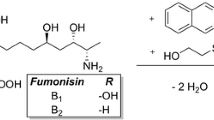Abstract
A survey was conducted to determine the levels of fumonisins B1 and B2 in corn and corn-based products available in Colombia for human and animal consumption. A total of 120 samples were analyzed by acetonitrile-water extraction, cleanup with a strong-anion-exchange column, and liquid chromatography with o-phthaldialdehyde-2-mercaptoethanol derivatization and fluorescence detection. The samples of corn and corn-based products for animal intake were taken at different feed manufacturing plants, whereas the samples used for human foods where purchased from local retail stores. The number of positive samples for fumonisin B1 was 20.0% higher in corn and corn-based products for animal intake (75.0%) than in corn and corn-based products for human consumption (55.0%). The levels of fumonisin B1 were also higher in corn and corn-based products for animal intake (mean = 694 μg/kg; range = 32–2964 μg/kg), than in corn and corn-based products for human intake (mean = 218 μg/kg; range = 24–2170 μg/ kg). The incidence and levels of fumonisin B2 were lower than those for fumonisin B1. Corn and corn-based products for animal consumption had an incidence of fumonisin B2 of 58.3%, with a mean value of 283 μg/kg, and a range of 44–987 μg/kg. The incidence of fumonisin B2 in corn-based products for human intake was 35.0%, with a mean value of 118 μg/kg and a range of 21–833 μg/kg. The highest incidence and levels of fumonisins were found in samples of hominy feed, with concentrations ranging from 86 to 2964 μg/kg fumonisin B1 and 57 to 987 μg/kg fumonisin B2.
Similar content being viewed by others
References
Gelderblom WCA, Marasas WFO, Vleggaar R, Thiel PG, Cawood ME (1992) Fumonisins: isolation, chemical characterization and biological effects. Mycopathologia 117:11–16.
Norred WP (1993) Fumonisins - mycotoxins produced by Fusarium moniliforme. J Toxicol Environ Hlth 38:309–328.
Diaz GJ, Boermans, HJ (1994) Fumonisin toxicosis in domestic animals: a review.Vet Hum Toxicol 36:548–555.
Gelderblom, WCA, Snyman SD, Abel S, Lebepe-Mazur S, Smuts CM, Van der Westhuizen L, Marasas WFO, Victor TC, Knasmüller S, Huber W (1996) Hepatotoxicity and carcinogenicity of the fumonisins in rats. In: Jackson LS, DeVries JW, Bullerman LB (Eds) Fumonisins in Food, Plenum Press, New York, pp 279–296.
Sydenham EW, Thiel PG, Marasas WFO, Shephard GS, Van Schalkwyk DJ, Koch KR (1990) Natural occurrence of some Fusarium mycotoxins in corn from low and high esophageal cancer prevalence areas of the Transkei, Southern Africa. J Agric Fd Chem 38:1900–1903.
Chu FS, Li GY (1994) Simultaneous occurrence of fumonisin B1 and other mycotoxins in moldy corn collected from the People’s Republic of China in regions with high incidences of esophageal cancer. Appl Environ Microbiol 60:847–852.
IARC (1993) Monograph on the Evaluation of Carcinogenic Risks to humans, Toxins derived from Fusarium moniliforme: fumonisin B1 and B2 and fusarin C, IARC, Lyon, pp 445–466.
Shephard GS, Thiel PG, Stockenström S, Sydenham EW (1996) Worldwide survey of fumonisin contamination of corn and corn-based products. J Assoc Off Anal Chemlnt 79:671–687.
Campbell AD, Whitaker TB, Pohland AE, Dickens JW, Park DL (1986) Sampling, sample preparation, and sampling plans for mycotoxin analysis. Pure Appl Chem 58:305–314.
Park DL, Pohland AE (1989) Sampling and sample preparation for detection and quantitation of natural toxicants in food and feed. J. Assoc Off Anal Chem 72:399–404.
Sydenham EW, Shephard GS, Thiel PG, Stockenstrom S, Snijman PW, Van Schalkwyk DJ (1996) Liquid chromatographic determination of fumonisins Bl, B2, and B3 in corn: AOAC-IUPAC collaborative study. J Assoc Off Anal Chem Int 9:688–696.
Patel S, Hazel CM, Winterton AGM, Gleadle AE (1997) Surveillance of fumonisins in UK maize-based foods and other cereals. Food Addit Contam l4:187–191.
Trucksess MW (1996) Joint Mycotoxin Committee. J Assoc Off Anal Chem Int 79:318–321.
STATISTIX (1992) User’s Manual Version 4.0. Analytical Software, St. Paul, MN, USA.
Miller MA, Honstead JP, Lovell RA(1996) Regulatory aspects of fumonisins with respect to animal feed. In: Jackson LS, DeVries JW, Bullerman LB (Eds) Fumonisins in Food, Plenum Press, New York, pp 363–368.
Author information
Authors and Affiliations
Rights and permissions
About this article
Cite this article
Perilla, N., Diaz, G. Incidence and levels of fumonisin contamination in Colombian corn and corn products. Mycotox Res 14, 74–82 (1998). https://doi.org/10.1007/BF02945096
Received:
Accepted:
Issue Date:
DOI: https://doi.org/10.1007/BF02945096




